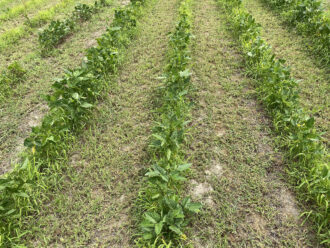MOUNT OLIVE, North Carolina – Rural farmers in eastern North Carolina are rediscovering the versatility, hardiness and protein-packed powerhouse of Southern pea – a long-forgotten household food staple.
“What was once old is now new again,” said Jason Davis, assistant dean of the School of Agriculture and Biological Sciences at the University of Mount Olive. Davis is leading a two-year project on conservation tillage systems of Southern pea (Vigna unguiculata) to determine which production practice best suits organic farming. The project is funded through a Southern Sustainable Agriculture Research and Education (SSARE) On-Farm Research Grant.
“The goal of the project is to compare the yield performance of two cultivars, Pink Eye Purple Hull ‘Quick Pick’ and ‘Top Pick’ between conventional tillage production and no-till and strip-till conservation practices,” said Davis. “We are seeking to address the lack of information on alternative tillage systems and address a demand from farmers who wish to grow the crop organically.”
On a blistering hot summer day at the Mount Olive George R. Kornegay Jr. Student Farm, rows of two-week old Southern pea plants peak up from the soil. They will be ready for harvest around mid-July.
Davis said that farmers in the area are keeping a close eye on how the study turns out. Many are interested in Southern pea either as a fresh market food crop, for seed, or as a livestock forage. Knowing how well the plants in the test plots fair with plant health, yield, and pest and weed management will go a long way in helping farmers better manage their own crop.
“Farmers in this area face a number of production challenges, the biggest one being the soil,” said Davis. Eastern North Carolina soils are loamy sand soils with high erosion rates, low moisture holding capacities, and some fertility issues. “You can only go so far down into the soil before you hit the plow pan. We don’t have a good handle on how extensive the root structure is for Southern pea, so knowing how the plant performs under various tillage systems is vital.”
Edward Olive, director for the University of Mount Olive Lois G. Britt Agribusiness Center, said that Southern pea is a hardy plant. “It’s drought tolerant, doesn’t require a lot of fertility, does well in poor soils, and from a nutrition standpoint is a good source of protein,” said Olive.
Anecdotally, it also seems to outgrow many pest issues.
“I can understand why farmers are interested in it,” said Olive. “If we can find a more sustainable means of growing the plant, it’s a good economic source and adds another crop to farmers’ diversification toolbox.”
Farmers in the area don’t specialize in just one crop. They produce such crops as cucumbers, squash, eggplant, potatoes, and peppers, and they are always looking for the next big crop to transition out of tobacco production.
Preliminary data from the study’s first year found that there were no significant differences between conventional tillage and strip-till regarding stand count and yields between the two varieties, although both were significantly higher than the no-till system.
Davis said that weeds posed a challenge in the no-till system, which may have contributed to lower yields. Researchers are currently exploring rye as a cover crop, which is terminated prior to Southern pea planting.
Researchers were also successful in mechanically harvesting the peas, meaning that labor-intensive hand harvesting can be replaced to allow commercial scale development of Southern pea production.
View Related SARE Grant:
- Southern Pea (Vigna unguiculata) Production Under Conservation Tillage Systems in North Carolina (OS21-145)
